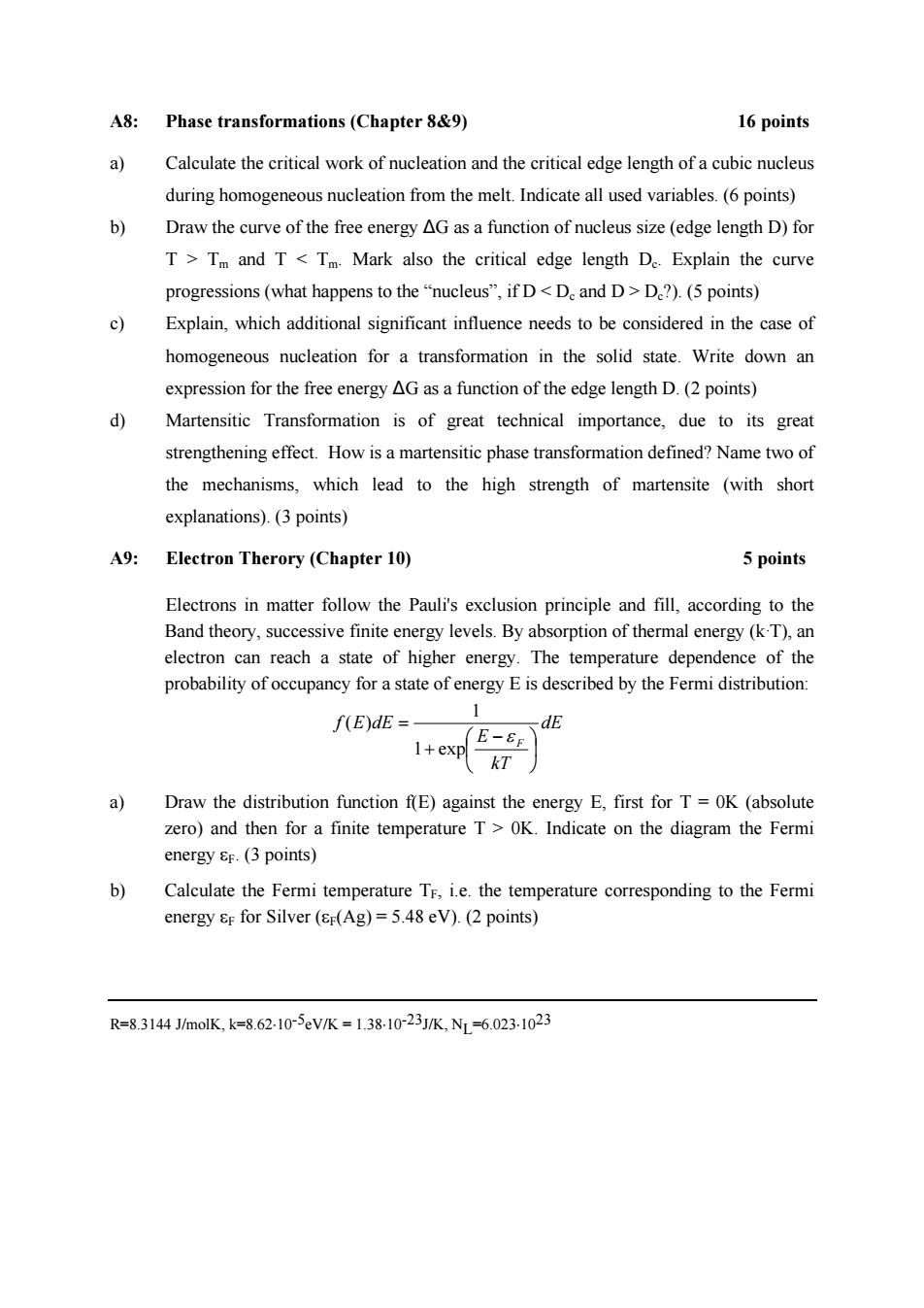正在加载图片...

A8:Phase transformations(Chapter 8&9) 16 points a Calculate the critical work of nucleation and the critical edge length of a cubic nucleus during homogeneous nucleation from the melt.Indicate all used variables.(6 points) b) Draw the curve of the free energy AG as a function of nucleus size (edge length D)for T>Tm and T Tm.Mark also the critical edge length De.Explain the curve progressions(what happens to the"nucleus",if D<De and D>De?).(5 points) c)Explain,which additional significant influence needs to be considered in the case of homogeneous nucleation for a transformation in the solid state.Write down an expression for the free energy AG as a function of the edge length D.(2 points) d Martensitic Transformation is of great technical importance,due to its great strengthening effect.How is a martensitic phase transformation defined?Name two of the mechanisms,which lead to the high strength of martensite (with short explanations).(3 points) A9: Electron Therory (Chapter 10) 5 points Electrons in matter follow the Pauli's exclusion principle and fill,according to the Band theory,successive finite energy levels.By absorption of thermal energy (k T),an electron can reach a state of higher energy.The temperature dependence of the probability of occupancy for a state of energy E is described by the Fermi distribution: f(E)dE = -de 1+exp E-EF a) Draw the distribution function fE)against the energy E,first for T =OK (absolute zero)and then for a finite temperature T>OK.Indicate on the diagram the Fermi energy EF.(3 points) Calculate the Fermi temperature TF,i.e.the temperature corresponding to the Fermi energy &r for Silver (F(Ag)=5.48 eV).(2 points) R=8.3144J/molK,k=8.6210-5eV/K=1.38-10-23J/K,=6.023-1023A8: Phase transformations (Chapter 8&9) 16 points a) Calculate the critical work of nucleation and the critical edge length of a cubic nucleus during homogeneous nucleation from the melt. Indicate all used variables. (6 points) b) Draw the curve of the free energy ΔG as a function of nucleus size (edge length D) for T > Tm and T < Tm. Mark also the critical edge length Dc. Explain the curve progressions (what happens to the “nucleus”, if D < Dc and D > Dc?). (5 points) c) Explain, which additional significant influence needs to be considered in the case of homogeneous nucleation for a transformation in the solid state. Write down an expression for the free energy ΔG as a function of the edge length D. (2 points) d) Martensitic Transformation is of great technical importance, due to its great strengthening effect. How is a martensitic phase transformation defined? Name two of the mechanisms, which lead to the high strength of martensite (with short explanations). (3 points) A9: Electron Therory (Chapter 10) 5 points Electrons in matter follow the Pauli's exclusion principle and fill, according to the Band theory, successive finite energy levels. By absorption of thermal energy (k·T), an electron can reach a state of higher energy. The temperature dependence of the probability of occupancy for a state of energy E is described by the Fermi distribution: dE kT E f E dE F 1 exp 1 ( ) a) Draw the distribution function f(E) against the energy E, first for T = 0K (absolute zero) and then for a finite temperature T > 0K. Indicate on the diagram the Fermi energy F. (3 points) b) Calculate the Fermi temperature TF, i.e. the temperature corresponding to the Fermi energy F for Silver (F(Ag) = 5.48 eV). (2 points) R=8.3144 J/molK, k=8.6210-5eV/K = 1.3810-23J/K, NL=6.0231023